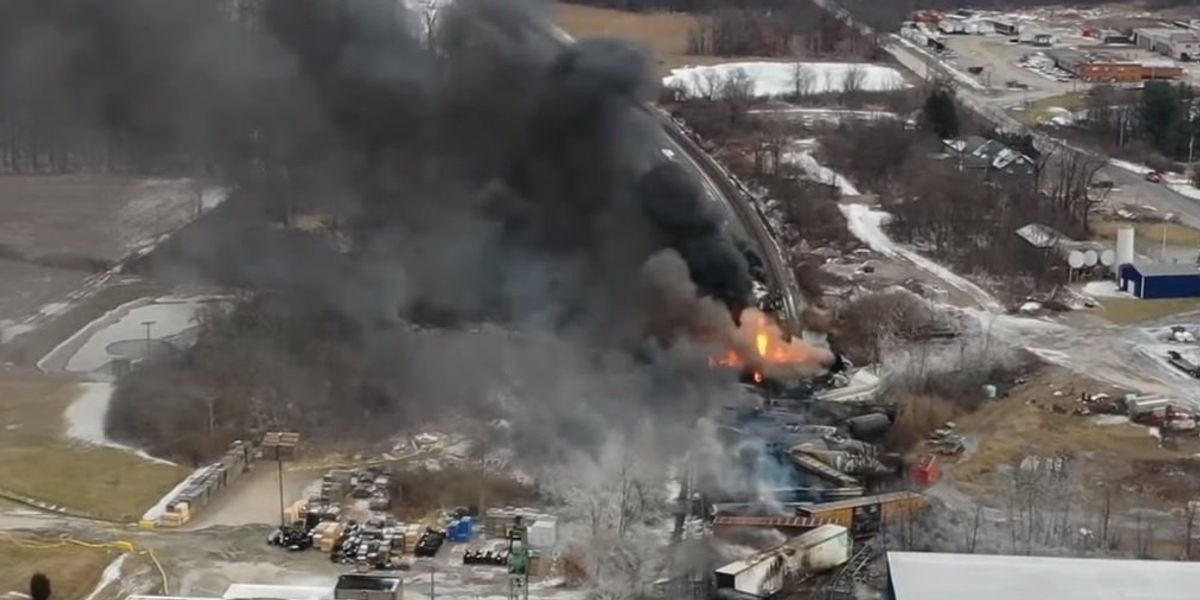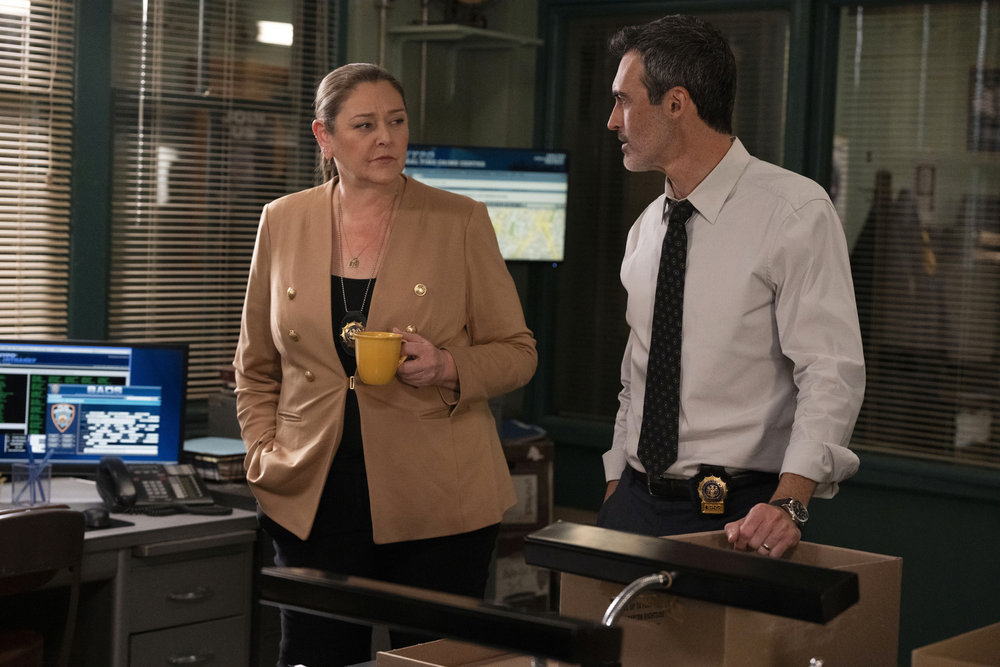Since we ran our story yesterday on the toxic Murdertrain derailment in East Palestine, Ohio, we’ve decided we were perhaps too willing to believe officials’ statements about the extent of possible harm to people in the area following the February 6 decision to release and burn the vinyl chloride in five tank cars to prevent the risk of an explosion.
Since our story ran, for instance, Ohio Gov. Mike DeWine (R) said in a press conference yesterday that people living near the derailment site should probably drink bottled water for the short term, although he also said that if he lived in East Palestine, he would feel safe returning home:
“I would be drinking the bottled water and I would be continuing to find out what the tests were showing as far as the air,” the governor said when asked about the hypothetical. “I would be alert and concerned, but I think I would probably be back in my house.”
We should note for the sake of accuracy that Gov. DeWine does not actually live in East Palestine.
Also, a bit more on the contamination of nearby streams and rivers, from WKYC-TV’s report on the briefing yesterday:
While containment measures have helped stabilize water quality levels, the Ohio EPA says roughly 3,500 fish from 12 difference species have died since the controlled explosion, and that the chemical burn made its way into six different waterways including the Ohio River, where a contaminant plume has made its way towards West Virginia.
“The farther it travels down the Ohio River, the more it is dissipating,” Surface Water Division Chief Tiffani Kavalec explained. “We haven’t seen a risk even at the most closest points to East Palestine, so we would not envision anything from this point forward impacting any of the further drinking water supplies.”
Also too, the American Prospect rounds up a number of stories from residents of the area who report a wide range of worrisome health symptoms they’ve experienced, despite the official statements that the air quality is safe. That story also looks at another aspect of the Murdertrain derailment that we only touched on briefly yesterday: the state of railroad safety in the USA, which maybe leaves a lot to be desired if you have derailments of tank cars carrying toxic chemicals.

Security video from a business in Salem, Ohio, 20 miles up the line from the derailment site, shows what appears to be sparks and flames coming from underneath the Norfolk Southern freight train; the National Transportation Safety Board (NTSB) says the video shows what “appears to be a wheel bearing in the final stage of overheat failure moments before the derailment.” The NTSB has collected that wheel set and the bearing bits for metallurgical testing. In general, you don’t want your trains to have wheel bearings bursting into flame.
An NTSB spokesperson said the train crew was notified of a mechanical failure, and that they then applied emergency braking, which is what led to the derailment. And here’s where the plot thickens: It turns out, the Lever reports, that Norfolk Southern “helped kill a federal safety rule aimed at upgrading the rail industry’s Civil War-era braking systems,” which of course it did. Regulations are bad for business, even if they increase safety.
Like all trains in the US, the Murdertrain used air brakes, a system invented in the 1860s by George Westinghouse. At the time, it was a hell of a big safety improvement over the previous system, in which brakemen had to literally run on the tops of the cars to turn a wheel that manually engaged the brakes. But nowadays, more advanced systems exist.
As you may recall from a million years ago when Barack Obama was president, there were a bunch of derailments of oil trains in 2013-14, including the 2013 explosion of a runaway train that leveled a small town in Quebec, killing 47 people. Other oil trains crashed and blew up in the US, too.
Rachel Maddow covered those “bomb trains” a lot at the time, and the Obama administration in 2014 proposed new safety regulations that would have applied to all trains carrying oil and hazardous materials. Thanks to rail industry lobbying, the final rule was whittled down so it only applied to trains carrying crude oil, excluding other hazardous stuff being shipped by rail.
Then in 2017, Donald Trump gutted the part of the rule that mandated advanced braking systems, and rail lobbyists rejoiced. The Lever explains what got undone:
Specifically, regulators killed provisions requiring rail cars carrying hazardous flammable materials to be equipped with electronic braking systems to stop trains more quickly than conventional air brakes. Norfolk Southern had previously touted the new technology — known as Electronically Controlled Pneumatic (ECP) brakes — for its “potential to reduce train stopping distances by as much as 60 percent over conventional air brake systems.”
But the company’s lobby group nonetheless pressed for the rule’s repeal, telling regulators that it would “impose tremendous costs without providing offsetting safety benefits.”
Great system, would make freight trains far safer, but we don’t want it because occasional disasters are less costly to our profit margin.
ECP braking applies the brakes evenly on all cars of the train at the same time, while air brakes are applied sequentially, from one car to another as the air pressure changes, resulting in cars bumping up against each other:
As one railroad industry insider told The Washington Post anonymously in 2016: “Trains are like giant Slinkies. When you have that back of the train running into the front of the train, they can actually push cars out, cause a derailment and cause a hell of a mess.”
ECP braking, the analyst said, takes “the energy out of the train quicker, so when a train does derail there is less energy that has to be absorbed by crushing tank cars.”
The Biden administration hasn’t tried to reinstate — or better, to broaden — the discarded Obama rule on ECP brakes, but this would be a very good time to put that on the to-do list. The railroad industry seldom initiates safety measures on its own. Tellingly, the railroads of the Gilded Age didn’t universally adopt the Westinghouse air brake system until Congress forced them to 30 years later. Yay, progressive era.
And yes, the safety experts say that if the Norfolk Southern train had been equipped with ECP brakes, the disaster in East Palestine might never have happened, or at least would have involved fewer cars leaving the rails.
“ECP brakes would have avoided that monster pile up behind the derailed car,” said Steven Ditmeyer, a former senior official at the Federal Railroad Administration. “In fact, depending on when the crew got the (error) notice from the wayside detector, applying the ECP brakes would have stopped everything very quickly.
“So I think it would have helped.”
As this USA Today story details, the resistance to ECP braking is just one example of the rail industry’s resistance to upgrading safety equipment and practices, because, again, profits. (See also overworked, overstressed train crews who can’t take paid sick leave.) Trains have been getting longer and heavier over time, which increases productivity and profits, but also makes the things harder to stop, especially in an emergency, because physics. All that momentum also adds to the potential for pileups following a derailment. The 150-car train that derailed in East Palestine was nearly 1.9 miles long, a not-unusual length for trains.
USA Today also notes that
The National Academies of Sciences, Engineering, and Medicine is now studying the impacts of trains longer than 7,500 feet, with federal officials looking to see if new regulations are necessary. That study is expected to be completed in November, according to the Federal Railroad Administration.
But wait! Maybe the railroads are all operating on such tight margins that they simply can’t afford safety upgrades! How’s Norfolk Southern doing in that area, anyway, Judd Legum’s Popular Information newsletter? It seems that with all the higher profits it’s managed to make by squeezing train crews’ schedules, Norfolk Southern has been busy doing stock buybacks,
a practice that benefits executives and investors by increasing the price. In March 2022, Norfolk Southern announced a plan to spend $10 billion on stock buybacks. In 2021, Norfolk Southern CEO James A. Squires received $14 million in total compensation. About $9 million of Squires’ compensation was paid in stock awards and options — assets that will likely increase in value as Norfolk Southern repurchases its shares.
So yes, now might be a really good time for the Biden administration to put the brakes on that shit.
[WKYC-TV / American Prospect / Lever News / USA Today / Popular Information / Guardian / Image: Screenshot, WTVO-WQRF on YouTube]
Yr Wonkette is funded entirely by reader donations. If you can, please give $5 or $10 a month so we can help keep your train of mind on the tracks.
























































![Key Metrics for Social Media Marketing [Infographic] Key Metrics for Social Media Marketing [Infographic]](https://www.socialmediatoday.com/imgproxy/nP1lliSbrTbUmhFV6RdAz9qJZFvsstq3IG6orLUMMls/g:ce/rs:fit:770:435/bG9jYWw6Ly8vZGl2ZWltYWdlL3NvY2lhbF9tZWRpYV9yb2lfaW5vZ3JhcGhpYzIucG5n.webp)




















